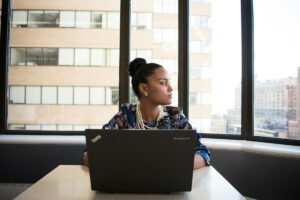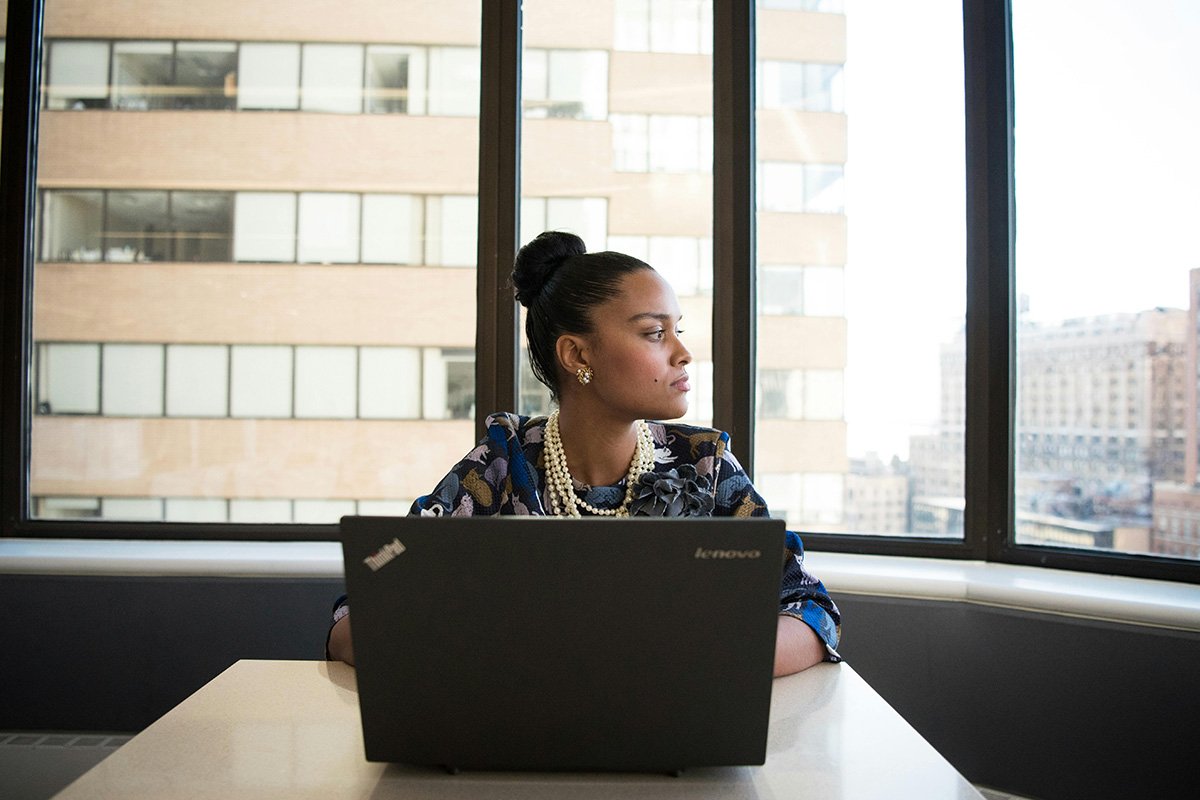
Despite facing unique marginalization, girls, femmes, and gender-expansive youth of color have historically been excluded from the philanthropic sector. Grantmakers for Girls of Color (G4GC)—the primary national philanthropic intermediary organization with a focus on these groups—is working to change that.
G4GC was founded during the COVID-19 pandemic and racial justice uprisings of 2020. As philanthropic efforts were stepping up to support Black men in their fight against systemic racism, G4GC emerged with a unique mission to invest specifically in girls and gender-expansive youth of color.
Monique Couvson, G4GC’s inaugural CEO, is an author and social justice activist who has spent the past three decades amplifying the fact that girls of color are often undersupported, adultified, and pushed into the school-to-prison pipeline.
In this interview with NPQ, Couvson talks about what led her into philanthropy, how her positionality as a Black woman informs her work, and why it is critical for more resources to be allocated toward girls and gender-expansive youth of color.
This interview has been edited for clarity and length.
Rebekah Barber: What led you to philanthropic work?
“As part of our theory of impact, we articulate reciprocity as a core value. That notion of reciprocity is not something that I would say could be divorced from my identity as a Black woman.”
Monique Couvson: I started consulting and advising a number of philanthropic organizations and leading research efforts for philanthropic organizations that were focused on issues that addressed [the] wellbeing of women and girls of color. In 2020, I made the transition fully to philanthropy as the inaugural CEO of Grantmakers for Girls of Color.
There’s almost no way to do nonprofit work or lead organizations that do work in the public interest and not be in relationship with philanthropy, so I’ve been in that type of relationship with philanthropy for most of my adult life.
RB: How does your positionality as a Black woman inform how you move in philanthropic spaces?
MC: My identity informs a lot of how I interact with individuals, how I understand the complexity of the issues that our grantee partners face, and the modalities that we have employed as an organization to try to respond and be in partnership with those communities.
As part of our theory of impact, we articulate reciprocity as a core value. That notion of reciprocity is not something that I would say could be divorced from my identity as a Black woman.
Much of how I have come to understand the possibility of justice and the promise of investments and partnerships is informed by the cultural elements of my communities that help me to understand what is possible when we work together and in spirit and exchange with each other, rather than in transactional ways that don’t require building trust.
“The specificity that we bring to our work at G4GC is a unique position in philanthropy and requires a unique investment.”
At G4GC, we have this saying that “we want to practice our grandmother’s philanthropy” as a way to call in the ancestral wisdom that informs how we do what we do.
That also invites us to think about all the ways that the women in our communities care for communities and create space for communities. That’s something that we actively engage in our approach to being in partnership with our grantee partners. That directly comes from my identity as a Black woman and how I saw my Black grandmother participate in and build communities.
I would also say that, as one of the few Black women leading a philanthropic organization in the United States, my identity also shapes whether people value our contribution to the field. We are in a moment where there is a lot of discussion about the contributions of Black women to our democratic spaces in exciting ways, and particular opportunities for the leadership of Black women to be celebrated and engaged. I remain hopeful that we are in a moment of shift around the types of investments that are made in organizations that are led by Black women and other women of color.
RB: G4GC started in 2020. Since then, there have been more conversations about the need to fund Black-led organizations. Have you begun to see some of those conversations translating into investments?
MC: I think we saw this shift almost immediately in 2020 when there was explicit energy around investing in Black-led organizations. Our challenge—and our opportunity—is around the fact that we are a Black woman-led institution, we work on gender issues, and the primary focus of our investments is girls and gender-expansive youth.
When people talk about investing in women and girls, they often mean that they’re investing in women. Unfortunately, even in our philanthropic strategies, sometimes we adultify girls. [Or] we think that by investing in girls’ issues writ large, we are investing in the issues that impact girls and gender-expansive youth of color. The specificity that we bring to our work at G4GC is a unique position in philanthropy and requires a unique investment.
Often, when people think of girls, they think that they’re cute, so they give cute money. What they’re missing is that the investments in girls and gender-expansive youth of color need to be robust because their contributions to our democratic processes are robust. Their contributions to our understanding of equity in learning spaces are robust. Their contributions to economic equality and investments are robust.
What we get from these communities often far outweighs what we put into them, and we’re trying to remedy that. If these young people are called and asked to participate at the levels that they have routinely participated in as youth when they grow up, they get sick. There’s a health cost.
What we want is for people to be well. We want our young people to thrive and live liberated futures because of the investments that we have made, not despite what we did or didn’t do.
RB: As someone who is intentional about helping youth to have decision-making power, can you talk about any specific ways that young people have informed you about their needs?
MC: One of the things that I think we do extremely well at G4GC is participatory engagement and what the field has understood as trust-based philanthropy, though we interpret that a bit differently than our colleagues in some spaces.
Sign up for our free newsletters
Subscribe to NPQ's newsletters to have our top stories delivered directly to your inbox.
By signing up, you agree to our privacy policy and terms of use, and to receive messages from NPQ and our partners.
We have young people who are advisors and fellows who are associated with a number of our initiatives. For example, our Black Girl Freedom Fund has a cohort of young people who regularly participate in the decision-making process regarding the distribution and selection of grants.
Our New Songs Rising initiative for Indigenous girls, in partnership with the Seventh Generation Fund for Indigenous Peoples, has a strong cohort that robustly engages in helping us understand and elevate our understanding about indigeneity and how we should be moving resources into Indigenous communities.
We launched a Future Economy Lab a few years ago that has morphed into an investment tool that will be largely informed by a body of research that included about 500 young people, including a smaller cohort of fellows, to help us identify what some of the catalytic factors are in their own communities that are worthy of investment. We will use that as a tool to guide our investments in communities moving forward.
Because much of my research has been led by and focused on participatory strategies, that’s been baked into how we do our work at G4GC. Many members of my team come from movement work or community work that involves participatory strategies or youth-led engagement. We’re very clear that young people live with a wisdom that is often undervalued by society.
“As an intermediary, we can only move out the resources into our communities that we receive, so if there’s a reduction of resources, then there’s a reduction in what we can move out into the community.”
We also have a number of younger staff members who are age 25 and younger, that allow for us to also deeply interrogate these matters when it’s internal facing. Throughout our organization we have been able to advance concepts around working with young people that are rooted in the experiences of those young people.
RB: In recent years, there have been attacks on funding efforts directed toward marginalized groups. Have you encountered this in your work? How have you navigated it?
MC: Unfortunately, we have experienced the backlash. I think whenever you do work that is explicitly focused on communities that have faced historical marginalization, you’re at risk of a backlash. As students of history, unfortunately, we’ve come to expect it.
The reduction in funding to efforts that explicitly name race and gender as opportunities [for] investment has been hurtful to us. As an intermediary, we can only move out the resources into our communities that we receive, so if there’s a reduction of resources, then there’s a reduction in what we can move out into the community.
We have explored ways of thinking through our mobilization strategies—how we can deepen our educational efforts to get people to understand that not only should they be investing in G4GC, but they should also be thinking about how to more robustly support our grantee partners.
A lot of community education still needs to take place. The data continues to tell us that even when [investments are] intended to reach young people as a population, the communities of color that G4GC reaches still suffer most in terms of marginalization and underinvestment.
We have to be explicit, intentional, and committed in our work for young people. We can’t just call on young people when we have a moment of crisis, and we want their labor, but we have to invest in their wellbeing along the way.
RB: Recently, more people became aware of the power of Black women to self-determine when a significant amount of money was raised in a short time during the Win With Black Women Zoom call that has since inspired similar efforts. Of course, these resources were raised for a presidential candidate, Kamala Harris, but does this give you hope that—even if attacks persist—Black people will be able to self-determine to meet their needs?
MC: I’ve always known that. One of the reasons we built the Future Economy Lab and worked in partnership with SecondMuse to create this investment vehicle that is not dependent on the trends in philanthropy is because I’ve always recognized the power of communities coming together and being organized and mobilized to make investments in our own communities.
The $1 Billion for Black Girls campaign is our only fund which has a click and pledge [donation platform] because it was very clear when we launched it that if people are motivated and educated, they will move resources into communities in robust ways.
In one of my books, Black Stats, I talked about how often Black people give. It’s often underquantified because of how Black people give and how philanthropy has moved in African American communities. The calls that have taken place to mobilize very quickly around a political candidate definitely inspire me to know that I was right.
When we are educated and organized, we’re able to move resources. People know Madam C.J. Walker—or Sarah Breedlove—as the inventor of a number of hair care products for Black Americans, but she also was a deep financial supporter of the anti-lynching movement.
Much of how significant change has shifted in our communities has not been at the whim of philanthropy or wealthy donors. It has largely been governed and moved by the people. I think there is an opportunity for us to think through how we educate our communities at large, about how we build out partnerships that allow for us to reach those communities that have been increasingly marginalized, and robustly return to our communities with investments that really grow the next generation to be as effective as previous generations have been in shifting political consciousness and public consciousness around key issues.
RB: Is there anything else you’d like to add?
MC: G4GC has had the unique experience of being a leader in this space because we are uniquely positioned around girls and gender-expansive youth of color. Our voice is a critical one.
We invite the partnerships, we invite the investments, we invite the opportunity to be in community with us and to learn with us. We do this work out of the spirit of reciprocity, and leading with this notion of reciprocity is praxis. But I hope that as we think about how G4GC has been able to mobilize within philanthropy to abundantly resource girls and gender-expansive youth of color in the US, we are thinking about ways of expanding that work even greater.
We have mobilized more than $25 million to nearly 400 organizations centering or led by girls and gender expansive youth of color. We did that in four years. That is an extraordinary amount for philanthropy, partly because we were being responsive to the global crisis of COVID-19, but also because we were in deep relationship with those communities.
As we’re interrogating how we engage with our communities and how we see young people, it’s really important for us to understand that reciprocity requires relationship.











